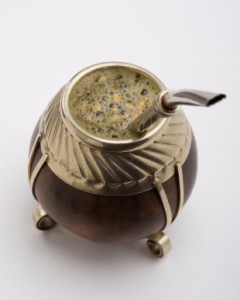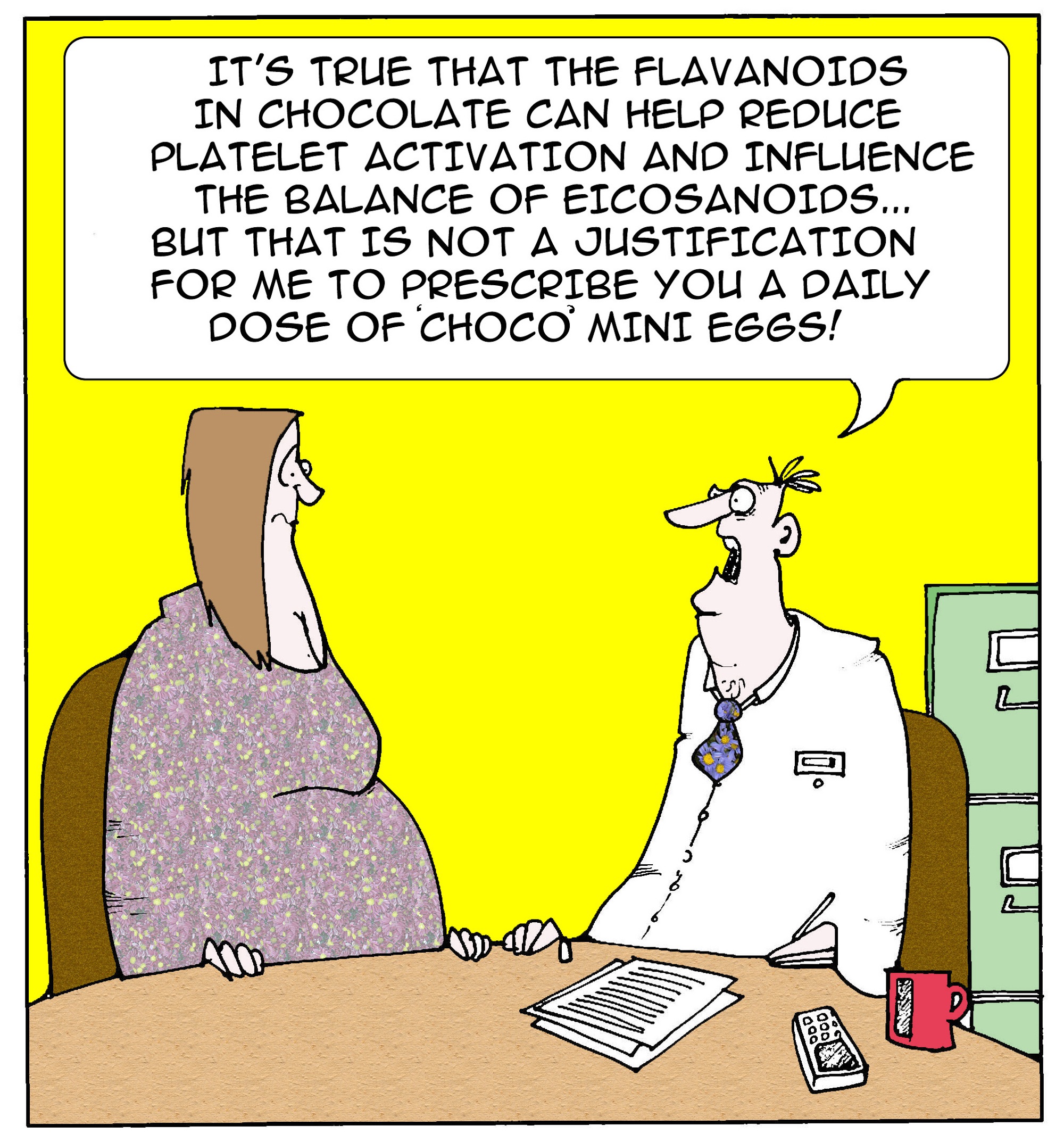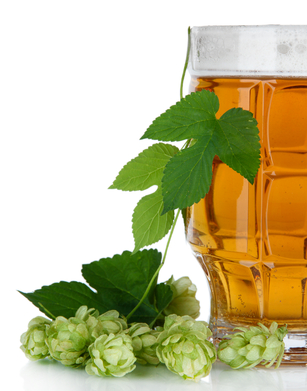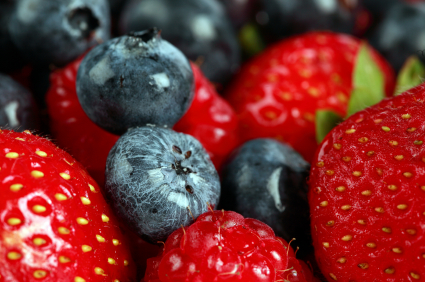Guyside: Chocoholic?
Oh, chocolate, you undo me.
I have a thing for chocolate. I love to eat it. Normally, this wouldn’t be a problem, right? Most people love chocolate. In the UK, people eat nearly 25 pounds of it every year. Here in North America, the average Canadian or US citizen eats lots less – about 11 pounds or so, but that’s still a lot.I figure if I quit, that average would go down by a pound or so.
With the gourmetization of everything, you’d think that this would be a good thing – consuming dark chocolate, with all those anti-oxidants and flavonoids is supposed to be good for you. But I have a taste – a craving – for the milky stuff. No nuts, no nougat, just good old milk chocolate. Perhaps it comes all the way from my childhood, when I used to have a big glass of Nestlé Quik for breakfast.
So when I think about how much chocolate I consume – bars, ice cream, gelato, etc. – I know that I’m consuming more of it than is likely healthy for me. Surely there are people out there that share this problem.
The key to me is that if I recognize this as a problem, then it is, at least for me.
So I decided to look for some tips to break this down a little bit, because I don’t necessarily want to go cold-turkey-total-abstinence-never-shall-chocolate-touch-my-lips-again. I want to be able to enjoy it in more moderation.
A Harvard medical blog suggests that if you note these three characteristics, then you’re behaving in an addictive way:
- intense craving
- loss of control over the object of that craving
- continued use or engagement despite bad consequences.
Chocolate, the post tells us, stimulates brain responses similar to those produced by “real” drugs. Now, I haven’t sold my body yet for a Hershey bar, but I don’t like the craving. And I don’t plan on entering a rehab program. So what do the big heads at Harvard suggest?
They focus on a mindfulness-related technique: “The next time you feel the pull of chocolate, pay attention to it. But instead of automatically reaching for your preferred candy bar or fudgy ice cream, take a few moments to actively decide whether or not to indulge the desire. If you decide to have chocolate, focus on each bite, slowly, to extend the pleasure in it. If you decide to wait, enjoy the notion that you’re taking good care of yourself. (You can take the same approach to alcohol, cigarettes, and food in general if you are trying to lose weight.)”
I’m gonna give this a try. What techniques do you use to control food consumption?
Read MoreAre hops the key to relieving menopausal symptoms?
The other day, a colleague pointed me to an Andrew Weil piece on hops and menopause. And while I’ve not checked out the association lately, I did write a few pieces over the years about the potential benefits of hops and hop extract for relieving hot flashes and even boosting bone health. So, I took a gander over at the National Library of Medicine database and ran across a minireview from 2013. Here’s a bit of information for those of you who enjoy a beer or two.
Hop extract (better know in scientific circles as Humulus lupulus) has had a long history of use as a medicinal herb, especially for gynecologic conditions. It is even recognized by the European Medicines Agency, which has published a monograph outlining its safety and effectiveness. But even more importantly, hops evidently contains a subclass of flavonoids — plant metabolites — that have been shown to be the most potent phytoestrogen known to date. Clinical studies in women suggest that it can offer some relief from hot flashes, help prevent osteoporosis and impact sexual desire. And the fact that it is the ‘most’ potent? It’s interesting because most people don’t realize that to truly benefit from genistein, the most potent phytoestrogen derived from soy, one must be exposed to it throughout their lifetime. On the other hand, studies of 8-PN show that it is quickly absorbed and blood levels can also be reached fairly quickly so that women can benefit relatively shortly after taking a supplement. Less clear is the proper dosage need to alleviate menopause complaints. This hops extract has also been studied in vaginal gel form for vaginal atrophy, although no firm conclusions could be drawn for that use.
So far, the benefits of 8-PN appear to be limited to hot flashes, bone health and sexual motivation. The data on safety are less robust.
Will drinking beer help your hot flashes? The answer isn’t clear. But I still believe that there is hope for hops.
Read MoreCan yerba mate protect your bones?
 Have you heard of yerba mate? Made from dried, ground leaves and twigs of a tree indigenous to South America (Ilex paraguariensis), yerba mate is a caffeinated beverage that is steeped in hot water and drunk through a metal straw inserted into a dried gourd. This method of consuming yerba mate is known as mate cebado. Like coffee, tea and colas, yerba mate contains a stimulant (xanthine), and on average, contains about 330 mg of caffeine for every (1.5 quarts) consumed.
Have you heard of yerba mate? Made from dried, ground leaves and twigs of a tree indigenous to South America (Ilex paraguariensis), yerba mate is a caffeinated beverage that is steeped in hot water and drunk through a metal straw inserted into a dried gourd. This method of consuming yerba mate is known as mate cebado. Like coffee, tea and colas, yerba mate contains a stimulant (xanthine), and on average, contains about 330 mg of caffeine for every (1.5 quarts) consumed.
Why the interest? Well, coffee and consumption of caffeine have been linked to lower bone mineral density, accelerated bone loss and increased fracture risk, all major red flags for women as they age who become increasingly at higher risk for osteoporosis. Conversely, beverages like green and black tea, both of which have considerable caffeine content, are reportedly protective of bone. So, what about yerba mate and your bones?
In study in the January 2012 issues of Bone, researchers looked at the effect of yerba mate in postmenopausal women who drank at least a liter per day (prepared as mate cebado) for five years. These women were sedentary, did not smoke or also drink more than three cups of coffee or tea daily, were not on HRT or bisphosphonate therapy and used alcohol moderately. Yet, when they were compared to women of similar age and menopausal status who did not drink yerba mate, they were found to have higher bone mineral density levels at both the spine and hip. And, when researchers delved deeper, they found that only one other factor — body mass index — similarly and positively affected these BMD measures.
However, yerba mate contains high levels of xanthine, the same stimulant implicated in coffee’s detrimental effect on bone, implying that it wouldn’t be bone protective, right? A possible explanation for these positive bone effects is that yerba mate contains organic compounds, such as in particular, polpyphenols (antioxidant chemicals), flavonoids and alkaloids that may confer these positive benefits.
Before you start changing your caffeine habits, there are a few things that you need to know. Yerba mate has been linked to esophogeal and oral cancer and cancer of the larynx (although this may be associated with the temperature of the drink as well as the compound itself). Because it contains such a high level of stimulant, it may not be safe for people with high blood pressure who are especially sensitive to caffeine or who are taking blood pressure medications. Finally, there is some indication that in high doses, yerba mate can negatively affect the liver. So, it’s a beverage that’s best in moderation (take note lovers of Guayaki Organic Energy Shots!).
Me? I’m going to stick with my coffee habit and counteract any negative bone impact through weight bearing exercise. Still, it’s good to know that yerba mate may be an alternative worth looking into.
Read More
Wednesday Bubble: Women, Heart Disease & Diet
Yes, it’s Monday and I’ve already posted today’s piece. However, nothing like bursting the ol’ Wednesday Bubble early. So, ladies, listen up! When it comes to heart disease, namely a heart attack, your diet matters. In fact, researchers report that eating three or more servings of blueberries or strawberries a week can cut the risk of heart attack by as much as a third.
Nevermind the early Wednesday Bubble; have I got your attention yet?!!
Aging is a risk factor for heart disease, a leading cause of death in women. Moreover, the reason that more and more women start to die from heart disease as they grow older appears to have everything to do with the ability of cells to repair and replenish circulation and not much at all to do with waning hormone levels. You can read about that here. Cholesterol levels and weight gain also play a role. As does diet, in particular, the incorporation of flavonoids — compounds that are ubiquitous in nature — and found in many plant-based foods including fruits, vegetables, tea and wine. Yet, of the 4,000 some odd flavonoids that exist, which are the most beneficial in heart disease?
To tease out this answer, researchers followed over 93,000 women enrolled in the Nurses Health Study II over a period of 18 years. During this time, the women, all of whom were between the ages of 25 and 42 at enrollment, completed questionnaires about their diets every four years. Their findings? Women who reported eating higher levels of a subclass of flavonoids known as ‘anthocyanins,” which are responsible for the red, purple and blue colours of many fruits and vegetables, had as much as a 32% reduction in the risk for heart attack. Indeed, for every 15 mg increase in dietary intake of anthocyanins, the relative risk of having a heart attack declined by 17%. Importantly, these results remained unchanged even when researchers factored in other plant-based food constituents (such as potassium or folate), total fruit and vegetable intake, as well as alcohol drinking, and the presence of high blood pressure and/or diabetes.
The researchers point out that anthocyanins are believed to dilate arteries, counter the buildup of plaque and inhibit other mechanisms that contribute to atherosclerosis. Understanding how they work to counter the risk of a heart attack is important because the mechanisms underlying heart attack in younger and middle aged women versus their older peers, are different.
Of note, blueberries and strawberries were part of the analysis because they are the most eaten berries in the U.S. That aside, it is possible that eating other foods that have high levels of anthocyanins could produce similar benefits.
Want to stave off your risk of a heart attack? Eat more berries every week. It’s an easy fix for what could be a huge problem and there’s no time like the present to start on the path to heart health.
(This study appears in the online version of Circulation, the Journal of the American Heart Association.)
Read More
Loco for cocoa – chocolate and your heart
 Last June and August, I wrote about the link between eating chocolate and improving heart health. Briefly, researchers have long been interested in flavonoids and in particular (at least in so far as menopause goes) in isoflavones. (See soy posts for more on isoflavones). The specific compound or molecule of interest in cocoa (the non-fat component cocoa bean extract or liquor) are flavanols, which are also found in lower concentration in apricots, peaches, apples, green and black tea, red wine and cider). Note that the quantity of flavanols in chocolate depends on manufacturing, including fermentation and roasting, and how much treatment is given to reducing bitterness and improving consistency. What this means is that dark chocolate has the highest concentration of flavanols and milk, the lowest.
Last June and August, I wrote about the link between eating chocolate and improving heart health. Briefly, researchers have long been interested in flavonoids and in particular (at least in so far as menopause goes) in isoflavones. (See soy posts for more on isoflavones). The specific compound or molecule of interest in cocoa (the non-fat component cocoa bean extract or liquor) are flavanols, which are also found in lower concentration in apricots, peaches, apples, green and black tea, red wine and cider). Note that the quantity of flavanols in chocolate depends on manufacturing, including fermentation and roasting, and how much treatment is given to reducing bitterness and improving consistency. What this means is that dark chocolate has the highest concentration of flavanols and milk, the lowest.
What have researchers learned so far?
- Flavanols found in cocoa and cocoa powder may be powerful antioxidants and as such, help to mitigate certain factors that contribute to atherosclerosis, such as the formation of plaques in the arteries that lead to stroke and other coronary events. Thus, as antioxidants, they may actually neutralize toxic oxygen species circulating in the bloodstream.
- Experimental data suggest that ingestion of flavanols may help to regulate proteins and other compounds that encourage an inflammatory response to leads to heart disease.
- Flavanols may also help to stabilize the lining and muscular tone of the arteries and prevent them from narrowing.
- Additionally, flavanols may moderately protect against high blood pressures, although studies have been mixed.
- Finally, flavanols may help to maintain blood sugar levels and improve the ratio of good to bad fats in the blood.
However, while numerous studies suggest that chocolate may benefit the heart, less clear is whether or not a causal relationship exists. Still, the idea is attractive enough that researchers continue to delve into the potential benefits of functional foods containing flavonoids and in flavonols found in dark chocolate. This time, writing in the journal Appetite, they report on a newly published study that examined the effect of eating flavonoid-rich dark chocolate on a process called oxidative stress, in which the ratio of circulating oxygen free radicals to circulating antioxidants is imbalanced (free radicals are those nasty, unstable molecules or atoms that can wreak havoc and lead to disease, including heart disease, diabetes and high cholesterol).
Over a period of three weeks, 25 healthy men and women were asked to eat 50 g of dark chocolate daily. The women in this particular study were premenopausal, primarily because use of hormone replacement has been shown to modify oxidative stress that has been attributed specifically to LDL (low density lipoprotein, also known as the bad cholesterol). They also omitted any other cocoa products from their diet and tea, red wine and other drinks that were rich in antioxidants.
Not only did eating dark chocolate daily have no impact on body mass index or the subjects’ weight, but it significantly increased the percentage of HDL (high density lipoprotein or good cholesterol) and led to a significant declines in blood fats levels as well. Dark chocolate consumption also appeared to lower markers of oxidative stress and damage to good fats in cells by almost 27% in women in the study, indicating a favorable effect on LDL, a change that was not similarly observed in men. This suggests that eating dark chocolate could possibly benefit women more than men, at least in terms of the heart. And, while menopausal women were not studied, the researchers say that the protective role of dark chocolate could possibly be especially favorable during menopause, when waning levels of estrogen make women particularly sensitive to oxidative damage and heart disease.
As with similar studies, we still don’t have a definitive cause and effect. However, a little dark chocolate has the potential to go a very long way.
Read More








